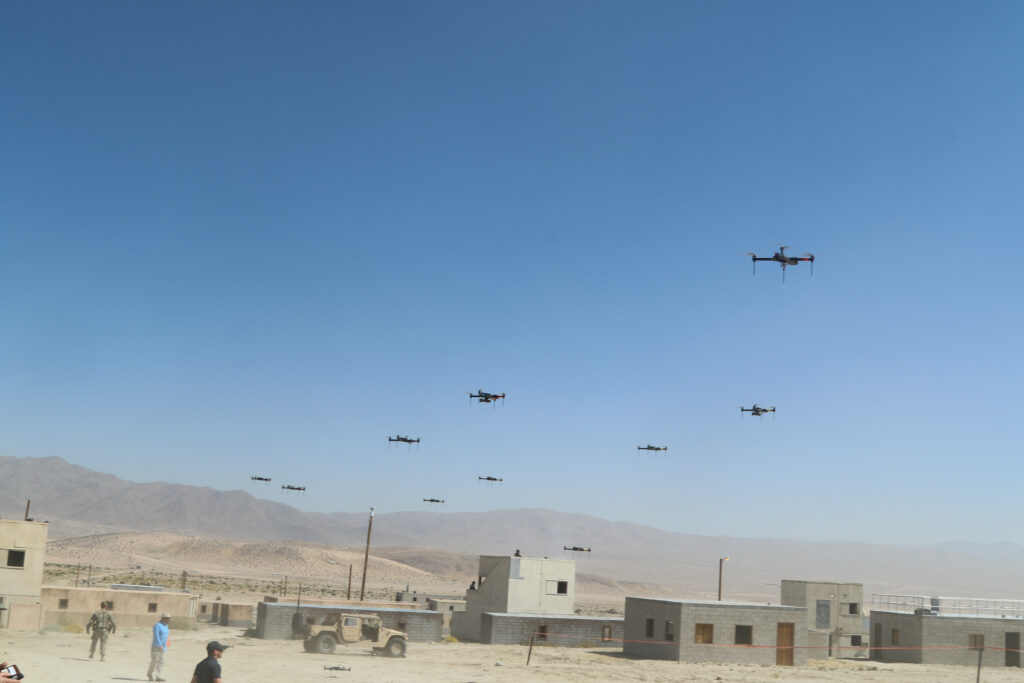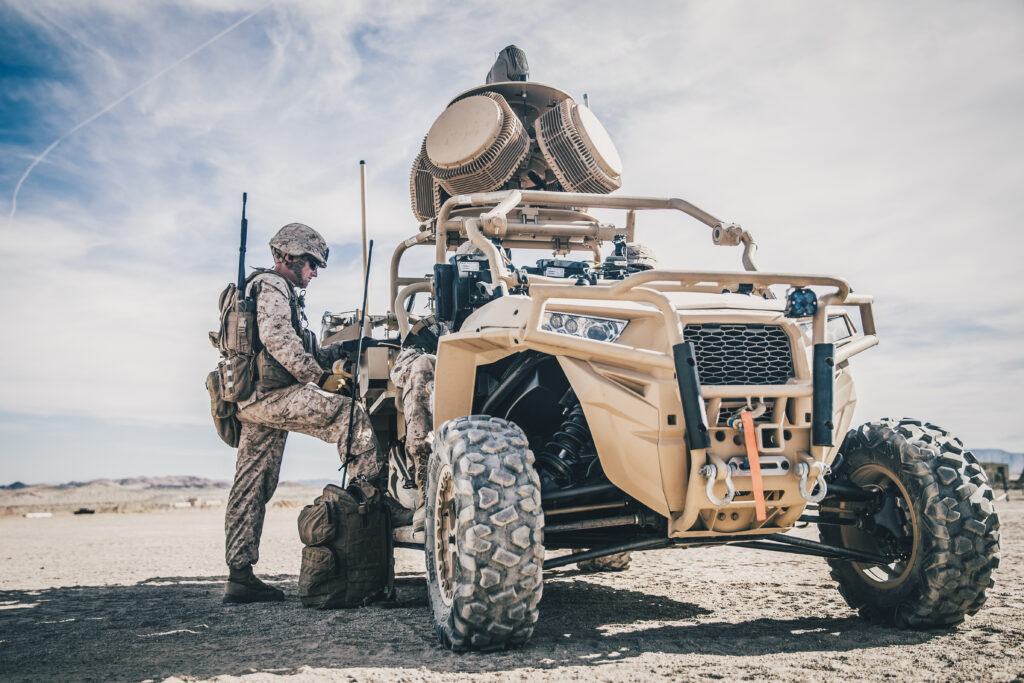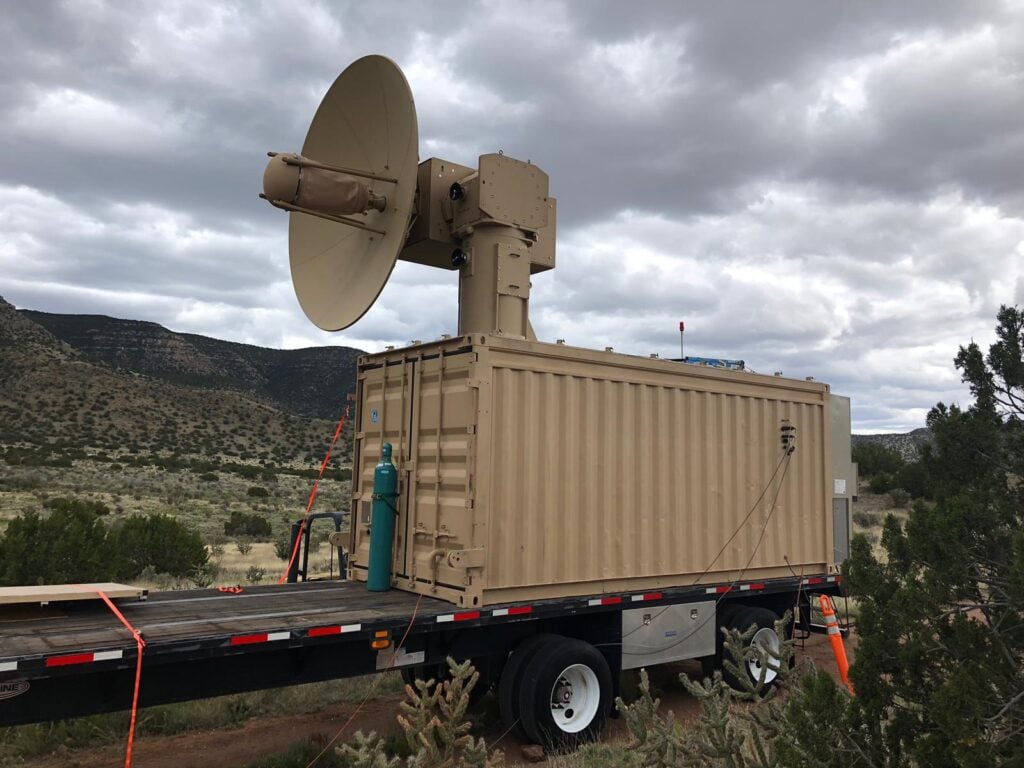
A swarm of 40 small drones fills the sky over the National Training Center during a 2019 exercise.
WASHINGTON: Got lasers? Jammers? Wireless hacking tools? Then check out the competition the Pentagon will formally kick off Friday, with an open invitation to industry to bring their “low collateral damage effectors” to Yuma Proving Ground this April. The objective: pick the best system or systems for all the armed services to buy to defeat small drones when physically shooting them out of the sky is too dangerous to civilians or friendly troops.
“Bring all your low-collateral effectors to the range first week of April, and we’ll select the best ones and move forward with that as the joint solution,” Maj. Gen. Sean Gainey said in a CSIS webcast Friday.

Maj. Gen. Sean Gainey
Gainey, an Army two-star, helms the all-service Joint Counter-UAS (Unmanned Air Systems) Office (JCO), which last week formally rolled out the Defense Department’s strategy to stop small drones.
But that strategy, Gainey’s remarks, and the low-collateral-damage effort itself all seem to emphasize the kinds of threats encountered in the Middle East, where terrorists have used relatively small numbers of small drones as both spies and improvised bombers.
That’s only half the problem, however. Nation-states like Russia, Iran, and even Azerbaijan are looking at how to deploy large swarms in large wars – a very different scale of threat that might require different kinds of countermeasures.
The Russian Ministry of Defense “is developing swarm tactics… spearheaded by key Russian military R&D institutions, such as the Advanced Research Foundation – Russia’s DARPA equivalent – and the ERA Tech city,” said Sam Bendett, a CNA analyst who studies Russian military robotics and other unmanned systems. “Several key Russian defense companies are also working on swarm technology.”

Sam Bendett
The recent Nagorno-Karabakh conflict in the Caucasus, in which Azerbaijani drones decimated Armenian tank units, “really pushed the MOD to think hard” about swarm warfare, Bendett told me.
While CSIS moderator Tom Karako tried to raise the great-power threat during Friday’s webcast, neither Gainey nor his civilian strategy chief, Nicole Thomas, actually addressed it during 75 minutes of discussions.
That doesn’t mean the military is blind to the danger, Karako told me afterwards. “I don’t think there’s any lack of attention, among the Joint Staff or the services, to how small UAS would fit into the high-end fight,” he said. “It’s not lost on anyone that Russia and China would bring to bear orders of magnitude more stressing challenge then what we’ve seen in the Armenia and Azerbaijan conflict or with Iran’s attack on Abqaiq.”
“We are absolutely considering the near and mid-term great power threat as we develop the key performance parameters that future systems must meet,” JACO spokesman Jason Waggoner told me. “The strategy is focused on dealing with sUAS [small Unmanned Air Systems] across the spectrum from hazards to threats, [and] it is intended to be flexible enough to deal with threats across the board.”

Tom Karako
“The dual attention to both FAA-style homeland airspace issues and more traditional military threats reflects the surge in the supply of small UAS and the complexity of the challenge,” Karako told me. “There’s going to be a thick mess of these things out there, and that’s why a strategy like this was necessary to begin grappling with it.”
Certainly, homeland security and counterterrorism deserve major attention. Even in US airspace, the FAA is still struggling to clamp down on irresponsible operators, set up mandatory registration, and require all drones to have a “remote ID” system that broadcasts what they. Gainey and Thomas were optimistic that remote ID will make things easier once it’s in place.
But a terrorist could still register drones under false pretenses and use them for espionage or even to carry explosives. As Amazon drone delivery and other commercial users proliferate, finding a few bad actors in a sky full of drones will become a needle-in-the-haystack problem – only the needles and the stalks of hay are flying around in all directions all the time.
That makes it crucial to understand the airspace around military bases and government buildings, a major focus for the JCO.

A Marine with the L-MADIS counter-drone system, sensors and jammers mounted on a Polaris M-RZR 4×4.
Enter JCO
The Joint Counter-UAS Office was created in 2019 to bring order to the dozens of different and often incompatible defenses bought in recent years. Last June, it narrowed those dozens down a list of just seven that the services are required to choose from. Even more important, the JCO required all counter-small-drone systems to be compatible with a common command-and-control (C2) architecture, based on the Army’s FAADC2, to allow them to share information and create a single “Common Operating Picture.” It’s also consolidating multiple threat databases into a single Common Threat Library, Gainey said, administered by the Army’s Intelligence & Information Warfare Directorate (I2WD).
“We want to go with common C2 standards so we create that common operating picture [so we can] make rapid decisions based off the threat that we’re seeing,” Gainey said. That’s part of the military’s move towards a system of Joint All-Domain Command & Control (JADC2) unifying all the services, he said. The goal is a meta-network able to share data among “any sensor, any shooter,” with common standards and modular interfaces that let the military plug-and-play new sensors and shooters into the network as technology improves.
That’s the context into which different companies’ individual products have to fit, like those being tested at Yuma in April. That is a joint effort by Gainey’s office, the Air Force, and the Army’s Rapid Capabilities & Critical Technologies Office (RCCTO), which leads ground-force development of cutting-edge tech like high-powered lasers and hypersonic missiles.
But what exactly is a “low collateral damage” counter-drone system, anyway? The Pentagon doesn’t want to be too specific about that, because they want to leave it wide open for companies to offer innovative ideas.
“The Low Collateral Effects Interceptor demonstration event is intended to find unique ideas and solutions on how to defeat small UAS in an environment that requires minimal collateral damage to the surrounding environment or personnel in the local area,” Waggoner, the JCO spokesman, told me in an email. “[That includes] defeating small UAS in urban environments, over sensitive sites, or situations where the rules of engagement would not allow kinetic effects. At this point we have not ruled out any specific interceptor technology or capability group.”
The next tech demonstration, Gainey said Friday, could be for a high-powered laser: The services are already developing such systems to shoot down drones. Unlike a physical bullet or anti-aircraft missile, a laser beam doesn’t drop back to the ground after hitting its target, making it less likely to do collateral damage. (That said, the dead drone has to come down somewhere).

The Air Force’s THOR high-powered microwave is designed to burn out swarms of attacking drones.
There are other low-collateral damage techniques available as well. High-powered microwaves, like the Air Force’s experimental THOR, can fry electronics from a distance – and the spread of their beams, like shotgun pellets, could help sweep swarms from the sky.
Another wide-area, low-collateral-damage technique is electronic warfare. Jamming radio frequencies can shut down drones’ remote-control links – although that’s not a defense against more sophisticated autonomous models – or blind their sensors.
The Russian military is arguably the world leader in electronic warfare, which it used to shut down Ukrainian communications and paralyze resistance. Ukraine also saw Russian deployment of drones to spot targets for devastating artillery strikes. But in Syria, Russia became a target for small drones itself. In response, it turned to electronic warfare as a key part of a layered defense.
“Russia has encountered the small UAS problem in Syria and devoted considerable resources to tackling the problem,” Bendett told me. “It created what it called ‘echeloned defense’: a combination of early warning radars, EW systems and air defense units which proved successful in dealing with smaller, DIY-style drones that struck its Hmeimim base.”
Countering small drones is now a standard part of Russian combat training, Bendett said, using everything from handheld small arms to electronic warfare. “Almost every EW exercise involves some form of C-UAS training, and other C-UAS drills involve EW,” he said.
On the offensive side, Bendett said, Russia has focused on developing small drones for reconnaissance and electronic warfare, not for direct attack. But, he said, “just like the US and other countries, the Russian military is discussing the use of UAS in swarms.”
Navy jet trainer fleet operations remain paused after engine mishap
One week after the incident, a Navy spokesperson says the service is continuing to assess the fleet’s ability to safely resume flight.


























